Do I need to increase CH?
- Thread starter Ezun
- Start date
You are using an out of date browser. It may not display this or other websites correctly.
You should upgrade or use an alternative browser.
You should upgrade or use an alternative browser.
- Jul 27, 2017
- 82
- Pool Size
- 28000
- Surface
- Plaster
- Chlorine
- Salt Water Generator
- SWG Type
- Pentair Intellichlor IC-40
Ok - so I cleaned it and it looked pretty darn clean. Here are photos of the panels inside.
The DE at the bottom of the filter frame and in the bottom of the filter housing was obviously grey, but nothing stands out to me.
Would love any ideas on what this may indicate for the stuff that’s on the metal around my lights.
The DE at the bottom of the filter frame and in the bottom of the filter housing was obviously grey, but nothing stands out to me.
Would love any ideas on what this may indicate for the stuff that’s on the metal around my lights.
Attachments
-
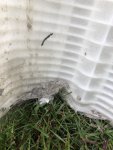 7BEFACB0-5D26-475A-B50C-6925CA41773D.jpeg455 KB · Views: 7
7BEFACB0-5D26-475A-B50C-6925CA41773D.jpeg455 KB · Views: 7 -
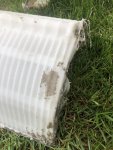 9992E560-5612-4213-94B1-85873A438D8B.jpeg533.4 KB · Views: 6
9992E560-5612-4213-94B1-85873A438D8B.jpeg533.4 KB · Views: 6 -
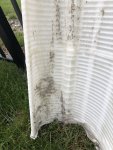 540F3190-7B9B-4A33-87ED-DAABFB8E2038.jpeg501.9 KB · Views: 7
540F3190-7B9B-4A33-87ED-DAABFB8E2038.jpeg501.9 KB · Views: 7 -
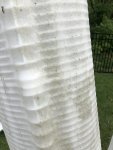 7128DA3B-D344-4E62-8A95-89230FC79800.jpeg425.2 KB · Views: 6
7128DA3B-D344-4E62-8A95-89230FC79800.jpeg425.2 KB · Views: 6 -
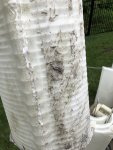 70E7A2DC-14D5-4E52-BC46-70F522A3D10A.jpeg450.3 KB · Views: 5
70E7A2DC-14D5-4E52-BC46-70F522A3D10A.jpeg450.3 KB · Views: 5 -
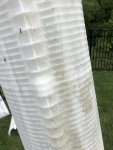 404395F4-2CC3-4D5B-BB0C-30BFFBA90B64.jpeg434.4 KB · Views: 6
404395F4-2CC3-4D5B-BB0C-30BFFBA90B64.jpeg434.4 KB · Views: 6
I’m not seeing any sort of metals. So, that’s a good thing.
However, if that’s what the grids look like before you hosed them off, then it looks like you might not be using enough DE.
I’m thinking that the dust on the light is specific to the light or niche. Possibly corrosion of the light face or main body. Or, the niche or parts in the niche.
The light face is good stainless. So, something corrosive, like acid or chlorine would need to make contact or possibly there’s some sort of stray current
However, if that’s what the grids look like before you hosed them off, then it looks like you might not be using enough DE.
I’m thinking that the dust on the light is specific to the light or niche. Possibly corrosion of the light face or main body. Or, the niche or parts in the niche.
The light face is good stainless. So, something corrosive, like acid or chlorine would need to make contact or possibly there’s some sort of stray current
- Jul 27, 2017
- 82
- Pool Size
- 28000
- Surface
- Plaster
- Chlorine
- Salt Water Generator
- SWG Type
- Pentair Intellichlor IC-40
Thank you @JamesW
I just put in 8 scoops of DE and have a pentair DE FNS Plus 48 filter. Is 8 scoops enough?
Thank you.
I just put in 8 scoops of DE and have a pentair DE FNS Plus 48 filter. Is 8 scoops enough?
Thank you.
You need about 1 lb of DE per 10 square feet of filter surface area.
So, that's about 4.8 lbs.
1 lb is about 48 fluid ounces.
So, that's about 230 fluid ounces.
So, that's about 4.8 lbs.
1 lb is about 48 fluid ounces.
So, that's about 230 fluid ounces.
- Jul 27, 2017
- 82
- Pool Size
- 28000
- Surface
- Plaster
- Chlorine
- Salt Water Generator
- SWG Type
- Pentair Intellichlor IC-40
Ok, I determined that I need to add 2 more scoops, since I only added 8 (which is the amount I should do during a backwash).You need about 1 lb of DE per 10 square feet of filter surface area.
So, that's about 4.8 lbs.
1 lb is about 48 fluid ounces.
So, that's about 230 fluid ounces.
- Jul 27, 2017
- 82
- Pool Size
- 28000
- Surface
- Plaster
- Chlorine
- Salt Water Generator
- SWG Type
- Pentair Intellichlor IC-40
I just remembered that I did let the backwash run for about 30 seconds before taking the filter apart, maybe that cleaned them up a bit?However, if that’s what the grids look like before you hosed them off, then it looks like you might not be using enough DE.
Ok, so how do I find this out? I’m thinking I get in and clean them with a magic eraser and see what comes back. Thoughts?The light face is good stainless. So, something corrosive, like acid or chlorine would need to make contact or possibly there’s some sort of stray current
Thanks again for all the help!
Backwash will remove DE from the grids. So, that could account for the lack of DE that we see on the grids.
The stainless steel face of the light should be smooth. If it feels rough, that could be corrosion.
If the light was never exposed to harsh chemistry, then you might have some sort of stray current.
Do you have any other metal that's corroding faster than usual?
The stainless steel face of the light should be smooth. If it feels rough, that could be corrosion.
If the light was never exposed to harsh chemistry, then you might have some sort of stray current.
Do you have any other metal that's corroding faster than usual?
- Jul 27, 2017
- 82
- Pool Size
- 28000
- Surface
- Plaster
- Chlorine
- Salt Water Generator
- SWG Type
- Pentair Intellichlor IC-40
So that explains the grids... good!Backwash will remove DE from the grids. So, that could account for the lack of DE that we see on the grids.
Ok - I’ll check the metal and make sure it’s smooth. I’m 99% sure it is because last year it was. But I will specifically check it.The stainless steel face of the light should be smooth. If it feels rough, that could be corrosion.
As for exposure to harsh chemicals - I don’t believe they have been. I personally have not exposed them to harsh chemicals. All chemicals are poured into the return stream as I put them into the pool to make sure they get mixed in appropriately and not to harm the pool in any way.If the light was never exposed to harsh chemistry, then you might have some sort of stray current.
All 3 pieces of metal in the pool have the same reaction. The 3 pieces of metal are 2 lights and ladder.Do you have any other metal that's corroding faster than usual?
My goal is to get in sometime in the next day or two, feel all of the metal, then clean it with a magic eraser and see if it comes back.
I did see that they grounded all of the rebar they used to build the pool and I see grounding wires for all of the pool equipment.
If this comes back, how do I test for stray current?
Chad
Stray current is tough to diagnose. You're going to have to do some research to get a plan to investigate if you're getting stray current.
- Jul 27, 2017
- 82
- Pool Size
- 28000
- Surface
- Plaster
- Chlorine
- Salt Water Generator
- SWG Type
- Pentair Intellichlor IC-40
Ok, so I dove in today and did my duty:
Felt the metal - totally smooth
Cleaned the metal as best I could (photo attached).
I also took the time to wipe down all of the tile all the way around the pool.
So, now I sit and wait to see if it all comes back.
Felt the metal - totally smooth
Cleaned the metal as best I could (photo attached).
I also took the time to wipe down all of the tile all the way around the pool.
So, now I sit and wait to see if it all comes back.
Attachments
If all of the metal is smooth and not pitting, then that's a good thing.
Hard to tell what the dust is.
Hard to tell what the dust is.
- Jul 27, 2017
- 82
- Pool Size
- 28000
- Surface
- Plaster
- Chlorine
- Salt Water Generator
- SWG Type
- Pentair Intellichlor IC-40
So far, no new pink dust on the metal.
Current question: Should I lower my PH? for some reason I feel like I should have it at 7.5 or 7.6, but reading here makes me think I might want to keep it higher - but I’m not sure why... maybe temp? 7.5 seems to be a great number for not bothering eyes/etc.
Thoughts on where my PH should be - and why?
Here’s a direct copy from the PoolMath App (which I totally love the more I use it!!)
==========================================
Pool
------------------------------------------
Build Type: Plaster
Volume: 33000 gallons
------------------------------------------
Latest Test Result Summary:
FC: 4.5 (52 minutes ago)
CC: 0.0 (52 minutes ago)
pH: 7.8 (52 minutes ago)
TA: 80 (52 minutes ago)
CH: 275 (2 days ago)
CYA: 60 (52 minutes ago)
SALT: 3200 (5 days ago)
BORATES: 80 (5 days ago)
TEMPERATURE: 80° (52 minutes ago)
CSI: -0.25 (52 minutes ago)
==========================================
Current question: Should I lower my PH? for some reason I feel like I should have it at 7.5 or 7.6, but reading here makes me think I might want to keep it higher - but I’m not sure why... maybe temp? 7.5 seems to be a great number for not bothering eyes/etc.
Thoughts on where my PH should be - and why?
Here’s a direct copy from the PoolMath App (which I totally love the more I use it!!)
==========================================
Pool
------------------------------------------
Build Type: Plaster
Volume: 33000 gallons
------------------------------------------
Latest Test Result Summary:
FC: 4.5 (52 minutes ago)
CC: 0.0 (52 minutes ago)
pH: 7.8 (52 minutes ago)
TA: 80 (52 minutes ago)
CH: 275 (2 days ago)
CYA: 60 (52 minutes ago)
SALT: 3200 (5 days ago)
BORATES: 80 (5 days ago)
TEMPERATURE: 80° (52 minutes ago)
CSI: -0.25 (52 minutes ago)
==========================================
- May 3, 2014
- 62,727
- Pool Size
- 6000
- Surface
- Fiberglass
- Chlorine
- Salt Water Generator
- SWG Type
- Pentair Intellichlor IC-40
- Jul 27, 2017
- 82
- Pool Size
- 28000
- Surface
- Plaster
- Chlorine
- Salt Water Generator
- SWG Type
- Pentair Intellichlor IC-40
@mknauss Thank you.Your pH is fine. When you test it at 8, lower it to 7.6.
Question for you - why is PH ok to be high in my current situation, but when you start a SLAM or with other pool situations I see suggestions to bring it down to 7.2 or maintain it around 7.5/7.6. Trying to understand the why.
Right now, it's because of the CSI. You want to keep it within plus or minus .3, and you're close.@mknauss Thank you.
Question for you - why is PH ok to be high in my current situation, but when you start a SLAM or with other pool situations I see suggestions to bring it down to 7.2 or maintain it around 7.5/7.6. Trying to understand the why.
During a SLAM, you can't test pH accurately at the elevated FC levels, and pH will rise over time, so you're just preparing for it.
- May 3, 2014
- 62,727
- Pool Size
- 6000
- Surface
- Fiberglass
- Chlorine
- Salt Water Generator
- SWG Type
- Pentair Intellichlor IC-40
The recommendation to lower the pH to 7.2 prior to SLAM is two fold. One, during a SLAM, you will not be able to test your pH due to FC interference. Also, chlorine is more effective at killing algae at lower pH.
Once in maintenance mode, you want your pH to stabilize as much as possible. That happens when it comes into balance with your TA, unless massive aeration or high TA fill water disturbs that balance. Naturally, water tends to want to be at a pH of 7.8 to 8.2.
Once in maintenance mode, you want your pH to stabilize as much as possible. That happens when it comes into balance with your TA, unless massive aeration or high TA fill water disturbs that balance. Naturally, water tends to want to be at a pH of 7.8 to 8.2.
Thread Status
Hello , This thread has been inactive for over 60 days. New postings here are unlikely to be seen or responded to by other members. For better visibility, consider Starting A New Thread.


